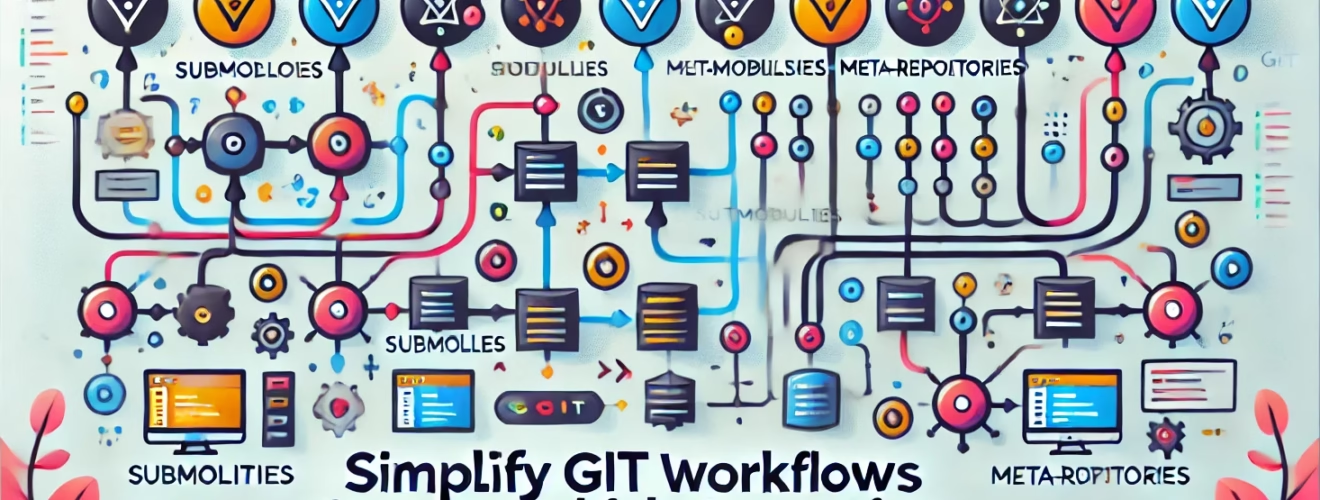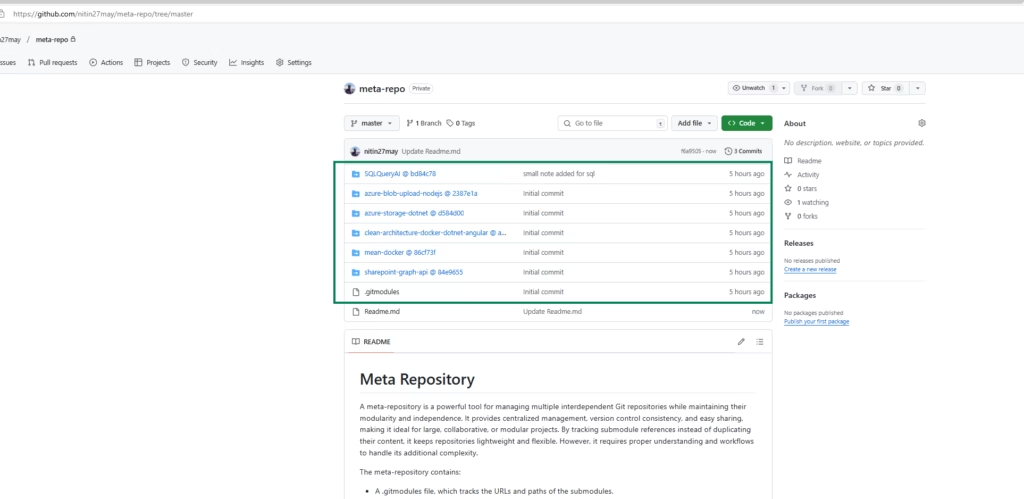Simplify Git Workflows Across Multiple Repositories with Git Submodules and Meta-Repositories
Managing multiple Git repositories in complex projects like microservices can become unwieldy. This comprehensive guide introduces meta-repositories and Git submodules as a solution for coordinating multiple repositories while maintaining their independence. Learn how to create, manage, and troubleshoot meta-repositories with practical examples and workflows suitable for both beginners and experienced developers working in distributed systems.
Introduction
In modern software development, projects often consist of multiple repositories working together seamlessly. For instance, microservices architectures rely on modularity, where each service has its own repository. While this independence is beneficial, managing numerous repositories as a single cohesive unit can be daunting. Enter the meta-repository: a powerful tool that simplifies the management of multiple interdependent Git repositories, enabling streamlined workflows without sacrificing modularity.
A meta-repository acts as a central hub, tracking references to individual repositories (submodules) rather than duplicating their content. It allows developers to work efficiently across multiple repositories, ensuring version consistency, centralized management, and reduced complexity.
The meta-repository contains:
A
.gitmodulesfile, which tracks the URLs and paths of the submodules.References to the specific commits of each submodule.
Optionally, other files for managing the project as a whole (e.g., documentation, configuration).
Why Choose a Meta-Repository?
Picture this: You are working on a microservices-based application, where each service lives in its own repository. While this setup promotes modularity and independent deployment, it can quickly become a nightmare for a developer juggling multiple repositories. Consolidating all projects into a single repository might sound tempting, but doing so undermines the very principles of modularity and independence that make microservices effective.
This is where a meta-repository shines. By using Git submodules, it enables developers to manage multiple repositories under one umbrella while preserving their autonomy. With a meta-repository, you can:
- Centralize Management
Group and control related repositories from one location.
Simplify workflows for fetching, updating, and deploying multiple repositories.
- Ensure Independence
Maintain submodules as independent repositories usable across other projects.
Enable developers to work on submodules without directly impacting the meta-repository.
- Guarantee Version Consistency
Track specific commits for each submodule, ensuring all team members work with the same versions.
Especially valuable in large systems with interdependent components.
- Streamline Cloning and Sharing
- Clone a meta-repository and its submodules in one step using
--recurse-submodules, reducing setup time.
- Clone a meta-repository and its submodules in one step using
- Promote Modularity
- Keep repositories maintainable and replaceable. Each submodule can be independently versioned, tested, or swapped.
- Reduce Redundancy
- Unlike manually copying repository content, meta-repositories track submodule references, minimizing duplication and keeping repository size manageable.
How to Create a Meta-Repository
Initialize the Meta-Repository
1
2
git init meta-repo
cd meta-repo
Add Submodules
1
2
3
4
5
6
7
8
9
10
11
12
git submodule add <repository1_url>
git submodule add <repository2_url>
# Repeat for all repositories
# Add the Remote Repository to the Meta-Repo:
git remote add origin <meta-repo-remote-url>
## Commit the Submodule Configuration:
git add .gitmodules
git add .
git commit -m "Initial commit with submodules"
##Push the Meta-Repository to the Remote:
git push -u origin main
Once it is pushed, you will able to see like below (links to all your repository)
Now to clone this repo, you can to normal git pull`
but if you would like to clone the meta repo and then all linked repositories, use like below :
1
git clone --recurse-submodules https://github.com/nitin27may/meta-repo.git
Initialize Submodules If submodules are not initialized, run:
1
git submodule update --init --recursive
Pull Updates for All Submodules To fetch the latest changes for all submodules (if already initialized)
1
git submodule update --remote --recursive
--remote: Pulls the latest changes from the tracked branch of each submodule.--recursive: Ensures nested submodules (if any) are also updated.
Workflow for Pushing Changes in Submodules
Steps
1
2
3
4
5
6
7
8
9
10
11
##1. Navigate to the Submodule
####1. Enter the directory of the submodule (your standalone project) where you want to make changes:
cd <submodule_folder>
##2. Make Changes in the Submodule
####1. Edit or add files as needed within the submodule.
####2. Stage and commit the changes:
git add .
git commit -m "Your changes in the submodule"
##3. Push Changes to the Submodule’s Remote Repository
####1. Push the committed changes to the remote repository of the submodule:
git push
After making changes in the submodule and pushing them, you need to update the meta-repository to track the new state of the submodule.
Updating the Meta-Repository to Track Submodule Changes
1
2
3
4
5
6
7
8
9
10
11
12
13
##4. Go Back to the Meta-Repository
#### Return to the root directory of the meta-repository:
cd ..
##5. Stage the Updated Submodule Reference
#### The meta-repository tracks a specific commit of the submodule. When the submodule changes, its reference in the meta-repository needs to be updated.
#### Stage the submodule reference update:
git add <submodule_folder>
## 6. Commit the Updated Reference
#### Commit the change in the meta-repository:
git commit -m "Updated submodule <submodule_name> to latest commit"
## 7. Push the Meta-Repository
#### Push the updated meta-repository to its remote:
git push
Collaborators and Cloning Updated Meta-Repository
Clone with Submodules
1
git clone --recurse-submodules <meta-repo_url>
Update Submodules in an Existing Clone
1
git submodule update --remote --recursive
Handling Issues: Submodule Changes Not Tracked by the Meta-Repository
When a developer commits changes directly in a submodule but does not update the meta-repository, inconsistencies can arise. For example, the meta-repository will continue referencing an older commit of the submodule, causing collaborators to miss the latest changes unless they manually update the submodule. Here’s how to address this:
1. Establish a Workflow Rule
Developers must:
Commit changes in the submodule.
Push the changes to the submodule’s remote.
Update the meta-repository:
1
2
3
git add <submodule_folder>
git commit -m "Update submodule reference to latest commit"
git push
2. Automate Meta-Repository Updates
Use scripts or Git hooks to detect and update the meta-repository:
Script Example:
1
2
3
4
5
6
7
8
#!/bin/bash
for submodule in $(git submodule--helper list | cut -d' ' -f4); do
(cd $submodule && git fetch --all && git status -uno | grep -q "Your branch is behind") && \
echo "Submodule $submodule has new commits!"
git add $submodule
done
git commit -m "Update submodule references"
git push
Pre-Push Hook:
1
2
3
# .git/hooks/pre-push
git submodule update --remote
git diff --exit-code || (echo "Submodules are out of sync. Commit their changes!" && exit 1)
3. Use CI/CD Pipelines
Leverage continuous integration tools to validate or enforce updates:
Configure your CI/CD pipeline to run a script that:
Pulls the latest submodule changes.;
Checks if the meta-repository is updated to reference the latest submodule commits.
Fails the build if the meta-repository is out of sync.
4. Manual Check for Outdated Submodules
Inspect submodule status:
1
git submodule status
Update the meta-repository if needed:
1
2
3
4
git submodule update --remote
git add <submodule_folder>
git commit -m "Update submodule reference to latest commit"
git push
Preventing Issues
- Team Training
Educate developers on the submodule workflow
Provide clear instructions on updating the meta-repository.
- Git Hooks or CI Validation
Use pre-push hooks to ensure submodules are properly updated.
Configure CI tools to detect and warn about out-of-sync submodules.
- Regular Synchronization
- Assign a team member to periodically check and synchronize submodules with the meta-repository. Tools like cron jobs or scripts can be used to automate these checks, and CI/CD pipelines can help enforce regular updates to ensure submodules remain in sync.
This approach empowers developers to efficiently handle complex projects, such as microservices architectures, where seamless coordination across repositories is crucial. Whether you’re centralizing management, promoting modularity, or reducing redundancy, a meta-repository provides the tools you need to succeed in collaborative and large-scale development environments.
In upcoming articles, we’ll dive deeper into challenges developers face when managing multiple repositories and propose solutions to streamline these workflows further.
Get Involved!
Join the Conversation: What challenges have you encountered when managing multiple repositories for a single project?? Share your thoughts and experiences in the comments!
Follow Us: Stay updated by following us on GitHub.

